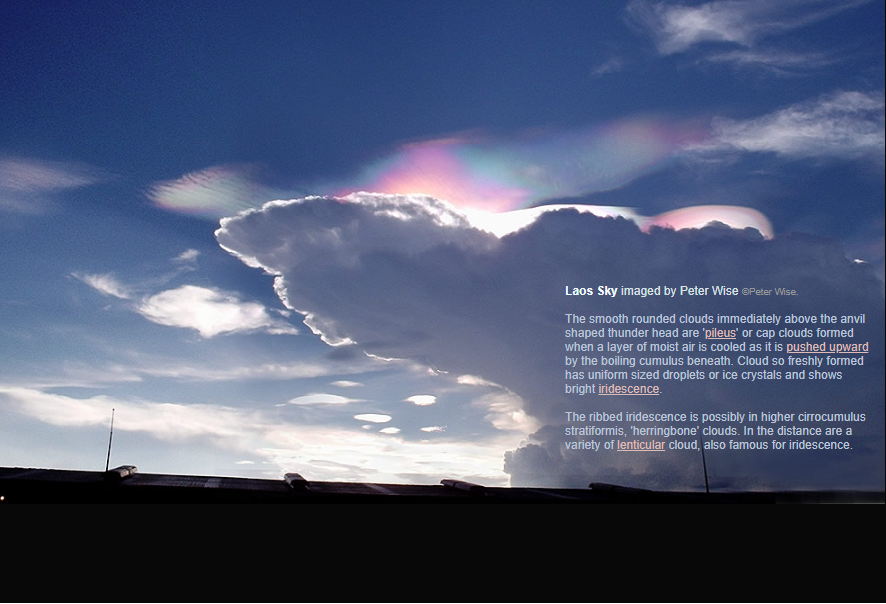Laos ~ Iridescent Sky
Laos ~ Iridescent Sky: A Mesmerizing Phenomenon in the Atmosphere
Have you ever looked up at the sky and been captivated by its beauty and wonders? The skies above Laos, a country in Southeast Asia, have been known to showcase a breathtaking atmospheric optics phenomenon known as the "iridescent sky." In this article, we will delve deeper into this mesmerizing occurrence and explore the science behind it.
Pileus Clouds: The Crowning Glory of Thunderheads
One of the striking features of the Laos iridescent sky is the presence of smooth rounded clouds positioned just above anvil-shaped thunderheads. These clouds, known as "pileus" or cap clouds, form when a layer of moist air is uplifted by the turbulent cumulus clouds beneath them. As this moist air rises, it cools rapidly, causing the water droplets or ice crystals within it to condense. The resulting pileus clouds exhibit a uniform size of droplets or ice crystals, giving them their characteristic bright iridescence.
Unraveling the Ribbed Iridescence
The ribbed iridescence observed in the Laos iridescent sky can be attributed to another type of cloud formation known as cirrocumulus stratiformis or "herringbone" clouds. These clouds appear in higher altitudes and display a distinct pattern resembling the bones of a fish. When sunlight interacts with the tiny water droplets or ice crystals present in these clouds, it undergoes diffraction, resulting in the separation of colors and the creation of vibrant ribbons of iridescence.
Lenticular Clouds: Shimmering Discs in the Distance
In addition to pileus and herringbone clouds, the iridescent sky in Laos often features lenticular clouds in the distance. These lens-shaped clouds are famous for their striking iridescence. Lenticular clouds form when moist air encounters a mountain or other elevated terrain, causing it to flow over the obstacle and create a wave-like pattern. The interaction of sunlight with the water droplets or ice crystals within these clouds produces shimmering colors, adding to the ethereal beauty of the sky.
The Science Behind Iridescence
To understand why the Laos sky exhibits such captivating iridescence, we must delve into the science of light and its interaction with atmospheric particles. When sunlight passes through the Earth's atmosphere, it undergoes scattering, diffraction, and refraction. These processes cause the separation of light into its constituent colors, resulting in the vibrant hues we observe in the sky. The size and shape of the particles present in the clouds determine the specific patterns and colors of iridescence that we see.
Exploring the Optics of Iridescence
Iridescence is not limited to the skies above Laos; it can also be observed in various other natural phenomena, such as soap bubbles, oil slicks, and certain bird feathers. The optical principles behind iridescence are similar in all these cases. When light interacts with thin films or microscopic structures, such as the water droplets or ice crystals in clouds, it undergoes constructive and destructive interference, resulting in the formation of distinct colors.
Atmospheric Optics: A Field of Endless Wonder
The iridescent sky in Laos serves as a reminder of the endless wonders that our atmosphere holds. Atmospheric optics, the study of how light interacts with the Earth's atmosphere, encompasses a wide range of phenomena, from rainbows and halos to mirages and glories. Scientists and enthusiasts alike continue to explore and unravel the mysteries of these phenomena, deepening our understanding of the intricate interplay between light and the atmosphere.
In conclusion, the iridescent sky above Laos is a truly awe-inspiring sight. The interplay of various cloud formations, such as pileus, herringbone, and lenticular clouds, creates a mesmerizing display of vibrant colors and ribbons of iridescence. By understanding the science behind these phenomena, we can appreciate the beauty and complexity of our atmosphere even more. So, the next time you find yourself gazing up at the sky, take a moment to marvel at the iridescent wonders that unfold above you.

Laos Sky imaged by Peter Wise ©Peter Wise.
The smooth rounded clouds immediately above the anvil shaped thunder head are 'pileus' or cap clouds formed when a layer of moist air is cooled as it is pushed upward by the boiling cumulus beneath. Cloud so freshly formed has uniform sized droplets or ice crystals and shows bright iridescence.
The ribbed iridescence is possibly in higher cirrocumulus stratiformis, 'herringbone' clouds. In the distance are a variety of lenticular cloud, also famous for iridescence.
Note: this article has been automatically converted from the old site and may not appear as intended. You can find the original article here.
Reference Atmospheric Optics
If you use any of the definitions, information, or data presented on Atmospheric Optics, please copy the link or reference below to properly credit us as the reference source. Thank you!
-
<a href="https://atoptics.co.uk/blog/laos-iridescent-sky/">Laos ~ Iridescent Sky</a>
-
"Laos ~ Iridescent Sky". Atmospheric Optics. Accessed on April 19, 2024. https://atoptics.co.uk/blog/laos-iridescent-sky/.
-
"Laos ~ Iridescent Sky". Atmospheric Optics, https://atoptics.co.uk/blog/laos-iridescent-sky/. Accessed 19 April, 2024
-
Laos ~ Iridescent Sky. Atmospheric Optics. Retrieved from https://atoptics.co.uk/blog/laos-iridescent-sky/.